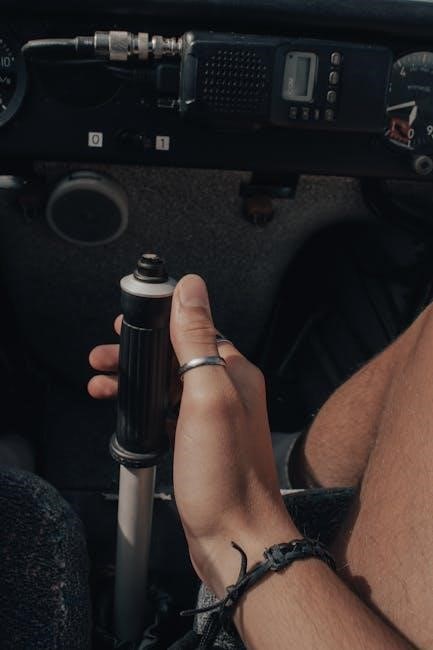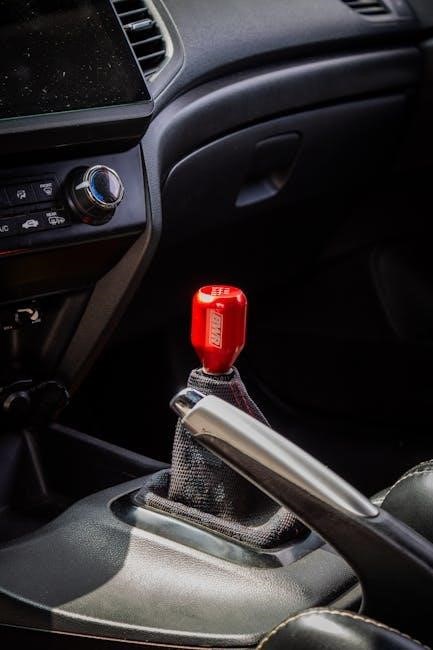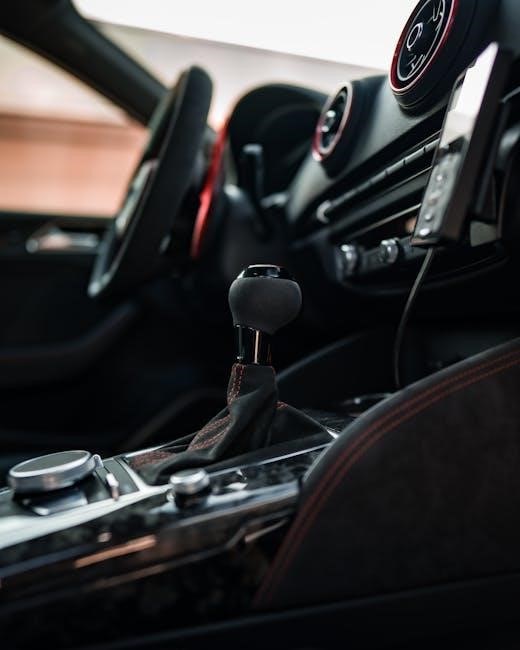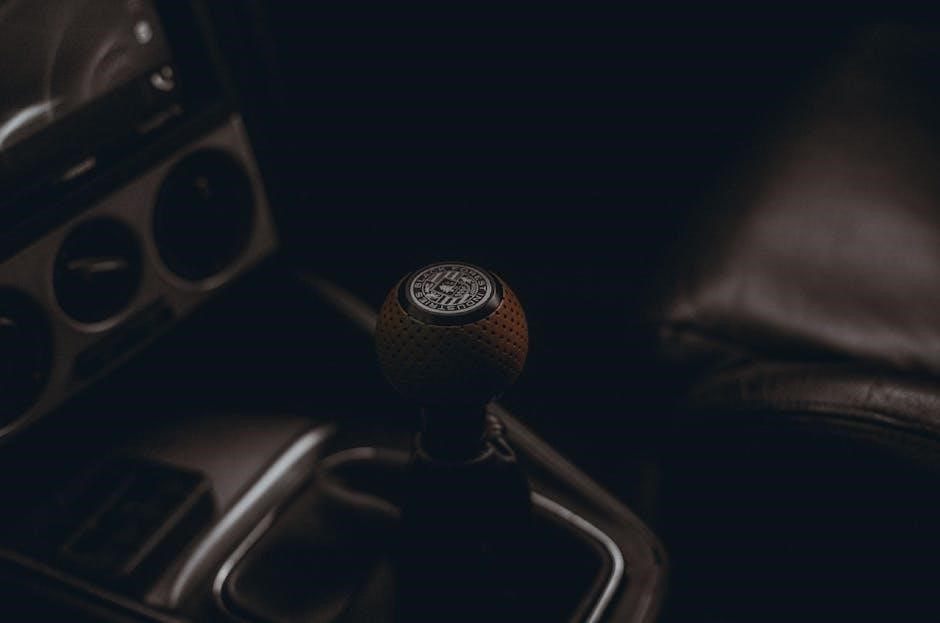Manual shift linkage is a critical mechanical system connecting the gearbox and clutch, enabling precise gear shifts and smooth vehicle operation, essential for driver control and performance․
Overview of Manual Shift Linkage
The manual shift linkage is a mechanical system designed to connect the driver’s gearshift to the vehicle’s transmission․ It enables the driver to manually select gears, ensuring precise control over the vehicle’s speed and torque․ This system is essential for vehicles equipped with manual transmissions, as it translates the driver’s input into mechanical movements that engage or disengage gears․ The linkage typically consists of cables, levers, and mounting points that work in harmony to synchronize the driver’s actions with the gearbox․ Proper alignment and adjustment of the linkage are crucial for smooth shifting and optimal vehicle performance․ Over time, wear and tear can affect its functionality, making regular maintenance necessary to prevent issues like sloppy shifts or complete gear disengagement․
Importance of Manual Shift Linkage in Vehicle Performance
The manual shift linkage plays a vital role in enhancing driving precision and efficiency․ By providing a direct connection between the driver and the gearbox, it allows for quicker and more accurate gear changes, which is especially crucial during high-performance driving or navigating challenging terrain․ A well-functioning linkage ensures smooth power delivery and optimal engine performance, reducing wear on other components like the clutch and transmission․ Additionally, it improves fuel efficiency by enabling drivers to maintain the most suitable gear for varying driving conditions․ Properly maintained linkages also enhance driver safety by preventing unintended gear shifts, making it a cornerstone of reliable and responsive vehicle operation;

Components of Manual Shift Linkage
The manual shift linkage consists of the gear lever, linkage rods, cables, and mounting points, all working together to transfer the driver’s gear shift inputs to the gearbox;
Key Parts of the Manual Shift Linkage System
The manual shift linkage system comprises several essential components․ The gear lever, located inside the vehicle, is the primary interface for driver input․ It connects to a shift cable, which transmits the driver’s movements to the gearbox․ Linkage rods and mounting points ensure stability and precise alignment․ Additionally, end stops prevent over-shifting, while return springs reset the gear lever to its neutral position․ Together, these parts ensure smooth, accurate gear transitions, making the system vital for optimal vehicle performance and driver control․ Proper maintenance of these components is crucial to avoid mechanical failures and ensure consistent shifting efficiency․
Role of Cables, Levers, and Mounting Points
The cables in a manual shift linkage system act as the primary connectors, transmitting the driver’s gear selection from the gear lever to the gearbox․ They must be durable to withstand mechanical stress and ensure precise control․ The levers, such as the gearshift lever, serve as the driver’s interface, converting physical movements into mechanical signals․ Mounting points secure the linkage components, ensuring proper alignment and stability․ These elements work together to maintain smooth, accurate gear transitions․ Regular inspection of cables and levers is essential to prevent wear and tear, while secure mounting points ensure the system operates without misalignment or play, guaranteeing reliable performance and driver control․

How Manual Shift Linkage Works
Manual shift linkage transmits the driver’s gear selection input through a system of levers and cables, mechanically engaging the gearbox to execute precise and smooth gear transitions․
Connection to the Gearbox and Clutch System
The manual shift linkage system connects the driver’s gearshift to the gearbox and clutch mechanism, translating movements into precise gear selections․ This connection ensures smooth power transfer and control․
Synchronization of Driver Input and Gear Shifts
The manual shift linkage ensures seamless synchronization between the driver’s gearshift movements and the actual gear changes in the gearbox․ This system relies on precise mechanical connections to translate the driver’s input into accurate gear selections․ The linkage transmits the driver’s intentions through cables, levers, and mounting points, maintaining proper alignment and responsiveness․ This synchronization is crucial for smooth power delivery, optimal acceleration, and control during driving․ Proper adjustment and maintenance of the linkage system are essential to ensure that driver input is accurately reflected in gear shifts, avoiding misalignment or delay that could compromise vehicle performance and driver experience․

Installation and Adjustment of Manual Shift Linkage
Installing and adjusting manual shift linkage requires precise alignment and calibration to ensure smooth gear transitions․ Properly securing cables and levers is essential for optimal performance․
Step-by-Step Installation Process
Begin by disconnecting the battery to ensure safety․ Remove the old linkage components, including cables and levers․ Inspect and clean the mounting points thoroughly․ Install the new shift linkage, aligning it with the gearbox and clutch system․ Secure all bolts and connectors firmly․ Adjust the cable tension to eliminate slack, ensuring smooth operation․ Test the system by shifting through all gears to confirm proper engagement․ Finally, reconnect the battery and verify the linkage’s functionality during a test drive․ Proper installation ensures reliable performance and prevents mechanical issues․ Follow the manufacturer’s guidelines for precise alignment and torque specifications․ This process guarantees optimal functionality and durability of the manual shift linkage system․
Adjustment Techniques for Optimal Performance
Proper adjustment of the manual shift linkage is crucial for seamless gear shifts․ Start by loosening the cable adjuster and engaging each gear to ensure smooth operation․ Tighten the adjuster until resistance is felt, then back off slightly to avoid stiffness․ Check the shift lever’s alignment with the gearbox, ensuring it moves freely without binding․ Use specialized tools to fine-tune the linkage, adjusting the mounting points for precise alignment․ Test the system by shifting through all gears, verifying that each engages effortlessly․ Regular lubrication of moving parts prevents wear and tear․ Adjustments should be made gradually, testing after each change to achieve optimal performance․ Properly adjusted linkage enhances driving experience and reduces mechanical stress on the system․ Always refer to the manufacturer’s specifications for precise guidance․

Maintenance and Repair of Manual Shift Linkage
Regular lubrication of moving parts and inspection of cables for wear are essential․ Addressing issues promptly prevents major repairs and ensures smooth operation over time․
Regular Maintenance Practices
Regular maintenance ensures the longevity and efficiency of the manual shift linkage․ Key practices include inspecting cables for wear or fraying, lubricating pivot points, and checking mounting hardware for tightness․ Additionally, cleaning the linkage system to remove dirt and debris is crucial to prevent mechanical binding․ Drivers should also monitor the gear shift’s smoothness; any hesitation or stiffness may indicate a need for adjustment or repair․ By adhering to a routine maintenance schedule, potential issues can be identified early, preventing costly repairs and ensuring optimal performance of the transmission system․
Common Repairs and Troubleshooting
Common issues with manual shift linkage include worn or frayed cables, loose connections, and misalignment․ Drivers may notice symptoms like difficulty shifting gears or a “loose” feel in the gear lever․ Troubleshooting often involves inspecting the cables and linkage for damage or wear․ Adjusting the linkage to ensure proper alignment can resolve many issues․ In cases of severe damage, replacing the cables or mounting points may be necessary․ Regular lubrication of pivot points can prevent premature wear․ If problems persist, consulting a professional mechanic is recommended to avoid further damage to the transmission system․ Early intervention ensures smooth operation and extends the lifespan of the manual shift linkage․
Manual shift linkage is a vital system ensuring precise gear control and optimal vehicle performance, offering drivers reliability and efficiency when properly maintained and adjusted․
Manual shift linkage is a cornerstone of vehicle operation, providing precise control over gear shifts and clutch engagement․ Its role in connecting the gearbox and clutch ensures smooth transmission of power, enhancing both performance and efficiency․ By enabling drivers to manually select gears, it offers better control during acceleration, deceleration, and cornering, improving overall driving dynamics․ Properly functioning linkage reduces mechanical wear and tear, while also contributing to fuel efficiency․ Regular maintenance and adjustments are crucial to maintain optimal performance․ In summary, manual shift linkage is essential for reliable and responsive vehicle operation, making it a critical component for drivers seeking precision and control behind the wheel․
Final Thoughts on Manual Shift Linkage
Manual shift linkage remains a vital component in vehicles, offering precision and control that enhances driving experiences․ Its importance lies in its ability to seamlessly connect driver input to the gearbox and clutch, ensuring smooth and efficient gear transitions․ Proper installation, adjustment, and maintenance are key to maximizing its performance and longevity․ As automotive technology evolves, the manual shift linkage continues to play a significant role in delivering the responsiveness and reliability drivers expect․ Whether for everyday commuting or high-performance driving, this system remains indispensable, reinforcing its place as a cornerstone of vehicle mechanics for years to come․